-
PDF
- Split View
-
Views
-
Cite
Cite
T. J. Haworth, K. Shima, E. J. Tasker, Y. Fukui, K. Torii, J. E. Dale, K. Takahira, A. Habe, Isolating signatures of major cloud–cloud collisions – II. The lifetimes of broad bridge features, Monthly Notices of the Royal Astronomical Society, Volume 454, Issue 2, 01 December 2015, Pages 1634–1643, https://doi.org/10.1093/mnras/stv2068
Close - Share Icon Share
ABSTRACT
We investigate the longevity of broad bridge features in position–velocity diagrams that appear as a result of cloud–cloud collisions. Broad bridges will have a finite lifetime due to the action of feedback, conversion of gas into stars and the time-scale of the collision. We make a series of analytic arguments with which to estimate these lifetimes. Our simple analytic arguments suggest that for collisions between clouds larger than R ∼ 10 pc the lifetime of the broad bridge is more likely to be determined by the lifetime of the collision rather than the radiative or wind feedback disruption time-scale. However, for smaller clouds feedback becomes much more effective. This is because the radiative feedback time-scale scales with the ionizing flux Nly as |$R^{7/4}N_{{\rm ly}}^{-1/4}$| so a reduction in cloud size requires a relatively large decrease in ionizing photons to maintain a given time-scale. We find that our analytic arguments are consistent with new synthetic observations of numerical simulations of cloud–cloud collisions (including star formation and radiative feedback). We also argue that if the number of observable broad bridges remains ∼ constant, then the disruption time-scale must be roughly equivalent to the collision rate. If this is the case, our analytic arguments also provide collision rate estimates, which we find are readily consistent with previous theoretical models at the scales they consider (clouds larger than about 10 pc) but are much higher for smaller clouds.
1 INTRODUCTION
Collisions between giant molecular clouds in galactic discs are a candidate mechanism for triggering the formation of massive stars and potentially even massive star clusters. When two clouds collide, a dense layer of material rapidly forms which might provide the conditions required for high-mass star formation. This process has been studied in numerical simulations by, for example Stone (1970), Habe & Ohta (1992), Ricotti, Ferrara & Miniati (1997), Anathpindika (2010), Inoue & Fukui (2013), Takahira, Tasker & Habe (2014) and Wu et al. (2015), which show that collisions can indeed create the conditions required for high-mass star formation. Dobbs, Pringle & Duarte-Cabral (2015) used numerical simulations of gas evolving in a galactic potential to estimate a collision rate of about 1 per 10 Myr for clouds larger than about 10 pc. Similar estimates of the collision frequency for clouds larger than 10 pc have also been obtained by Tasker & Tan (2009), Tasker (2011) and Tasker, Wadsley & Pudritz (2015).
Observationally, many massive stars and star clusters have now been identified as possibly resulting from cloud collisions. Two particularly compelling examples are M20 (Torii et al. 2011) and NGC3603 (Fukui et al. 2014). These are star clusters which appear to be at a junction between two clouds with line-of-sight velocities differing by approximately 20 km s−1. Of course it is possible that such a configuration could result from an independent star formation scenario and a chance alignment of two other clouds along the line of sight. However, analysis of the 12CO (J = 3–2, 2–1 and 1–0) lines demonstrated that the components of these two separate clouds closest to the stellar cluster are being heated by the cluster – implying that they must be spatially coincident.
Another signature of cloud–cloud collisions is a broad bridge feature in position–velocity diagrams (hereafter p–v diagrams). This is two velocity peaks, spatially coincident but separated in velocity, with intermediate intensity gas at intermediate velocities. In Haworth et al. (2015), we produced synthetic p–v diagrams from a range of different simulations of molecular clouds, including cloud collisions and isolated clouds with radiative feedback. We found that indeed broad bridges appeared in our cloud collision models, but did not arise in any of the simulations of isolated clouds with radiative feedback (though in principle, a broad bridge could possibly arise given a favourable configuration of gas clouds merely coincident along the line of sight). Haworth et al. (2015) also compared the simulated p–v diagrams with observed broad bridge features towards M20, a site of collision according to Torii et al. (2011).
Broad bridges in p–v diagrams clearly can arise from cloud–cloud collisions; however, it is currently unclear for how long they should survive. Feedback from winds and the ionizing radiation field of any OB stars that form as well as the conversion of gas into stars and the finite lifetime of the collision will presumably limit the amount of time that broad bridge features are visible for. In this paper, we combine a series of analytic arguments with new synthetic observations of cloud collision models, both with and without radiative feedback, to try and address this question.
2 ANALYTIC ARGUMENTS REGARDING THE TIME-SCALE FOR DISRUPTION OF BROAD BRIDGES
In this section, we explore the time for which a broad bridge feature might survive. There are many processes that might act to remove the broad bridge such as the collision being completely braked or ending as one cloud punches through the other, radiative/mechanical feedback from massive stars and the conversion of gas into stars.
2.1 Preamble: what is the broad bridge
We begin by recapping what the broad bridge feature is in the context of a collision. Fig. 1 shows a schematic of a cloud–cloud collision, as well as a cartoon of the p–v diagram the observer would see. A smaller cloud (blue) drives into a larger cloud (red). The entirety of the smaller cloud undergoes collision quite quickly, resulting in a compressed layer that continues to move into the larger cloud. Between the bulk velocities of the compressed layer and larger cloud, there is intermediate-velocity gas (yellow). For the observer viewing angle in the schematic, the observer sees some redshifted component moving away from them, a blueshifted component moving towards them and the intermediate-velocity gas. In the p–v diagram, this manifests itself as two peaks along the velocity dimension, separated by lower intensity intermediate-velocity emission – the broad bridge feature. An example of a p–v diagram with a broad bridge towards in M20, taken with Mopra, is given in Fig. 2.

A schematic of a collision–observer system and a cartoon p–v diagram showing a broad bridge feature. Different colour components in the collision schematic correspond to the different colours on the p–v diagram.
The intermediate-velocity gas is replenished as long as the collision is still occurring, so in order to remove the broad bridge feature the collision either needs to end (being fully braked or with one cloud punching right through the other) or the compressed dense layer resulting from the smaller cloud needs to be at least partially removed.
2.2 Details of the collision
We consider a collision between two clouds in a scenario similar to that discussed by Habe & Ohta (1992). One cloud of radius R1 collides with a second, larger (R2), cloud at velocity vc. The entirety of the small cloud has been compressed after a time approximately given by tc ≈ R1/vc (this is a lower limit, since it assumes that the post-collision velocity is small). We work in a frame in which the larger cloud is stationary. After tc the compressed layer is still moving with some finite bulk velocity relative to the larger (in our frame, static) cloud, meaning that the broad bridge is still observable for some subsequent time-scale (to be determined below). Our considerations here are only very approximate, we do not include the effects of turbulence or instabilities that can arise in a compressive flow (e.g. McLeod & Whitworth 2013).
2.3 The collision time-scales
The broad bridge will disappear if the clouds break to the extent that they are no longer separated in velocity by more than half the sum of their turbulent velocity dispersions. If this happens, then only a single feature will appear in the p–v diagram. The broad bridge may also disappear if the smaller cloud punches right through the larger. To estimate these time-scales, we require a description of the smaller cloud velocity as a function of time.
2.3.1 Momentum-driven motion in the limit of constant deceleration
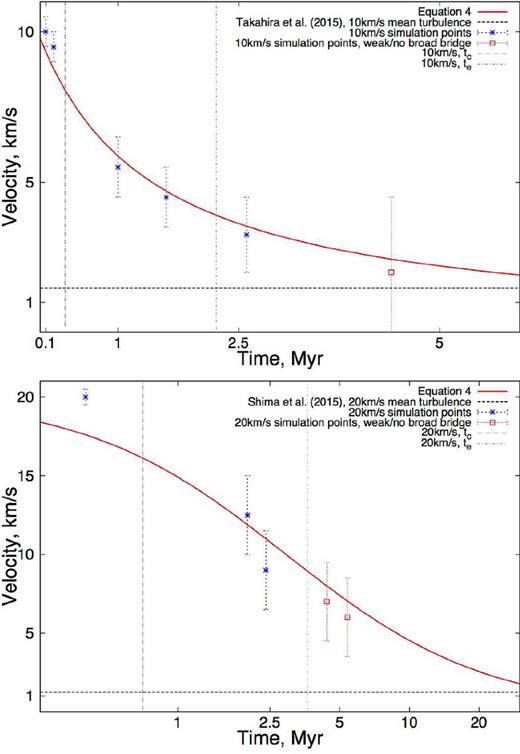
The velocity of the compressed layer as a function of time estimated using momentum balance and by assuming constant deceleration. The points are extracted from p–v diagrams/line profiles from synthetic data cubes of simulations (which we will discuss in Section 3). The width of the secondary peak in the broad bridge or ease with which two distinct velocity components can be identified determines the size of the error bars. The left-hand vertical line denotes the time after which the small cloud is compressed. The right-hand vertical line denotes the time after which the smaller cloud has punched through the larger.
The simple analytic approximation reproduces the values seen in the simulations to within (at worst) ∼20 per cent and will therefore be a suitable tool for giving a first-order estimate of the time-scale over which the broad bridge survives due to the overall collision lifetime. Although after tc the velocities predicted by our simple relation lie within the uncertainties (which are mostly based on how broad the two peaks of the broad bridge are), the simulations typically exhibit lower velocities than the analytic model predicts. This could be due to turbulent ram pressure braking the cloud further. The analytic solution also does not include gravity, which could affect the motion.
2.4 Radiative feedback disruption time-scale
During the collision material is compressed into a dense layer, which continues to travel into the larger cloud, giving rise to the secondary feature in the p–v diagram. It is also within this dense region that star formation (possibly massive star formation) will occur. However, once stars have formed their ionizing radiation will result in bubbles of hot gas that might disrupt the dense layer, potentially rendering it unobservable (at least in molecular lines) once some fraction of it has been ionized.
We plot the disruption time-scale as a function of ionizing flux for different cloud/collision parameters in Fig. 4, each assuming that the clouds have a density of 100 mH cm−3. We assume that the ionized and neutral gases have temperatures (sound speeds) of 104 and 10 K (11.5 and 0.19 km s−1), respectively. We also assume that the critical fraction of the cloud length that needs to be ionized is f = 0.5. Different lines in Fig. 4 correspond to different smaller cloud radii and collision velocities in the upper and lower panels, respectively. Since the radiative disruption time-scale scales as |$R_1^{7/4}$| but only |$N_{{\rm ly}}^{-1/4}$|, a reduction of the cloud size by a factor of 10 requires a reduction in the ionizing luminosity by a factor of 107 to maintain the same disruption time-scale. We therefore expect broad bridges to be disrupted more readily by radiative feedback in collision between smaller clouds, even if the ionizing luminosity is substantially lower. We will compare these relations with simulations in Section 3.
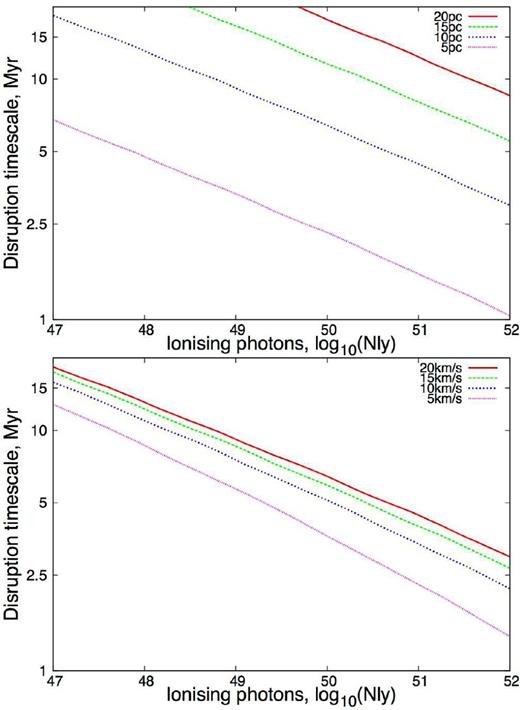
The time-scale for a broad bridge to be disrupted by radiative feedback as a function of ionizing flux. The upper panel is for a 20 km s−1 collision for different cloud radii. The lower panel is for a 10 pc cloud and different collision velocities. These plots assume that both colliding clouds have a density of 100 mH cm−3.
2.5 Stellar wind feedback disruption time-scale
Note that this assumes that the total wind luminosity goes in to disrupting the broad bridge.
Plots of the broad bridge disruption time-scale as a function of wind luminosity for a variety of cloud sizes and collision velocities are given in Fig. 5. Note that in these plots we assume a wind velocity of 2000 km s−1 and a gas density of 100 mH cm−3. We again calculate the mean dense layer velocity using the iterative procedure discussed in Section 2.4.
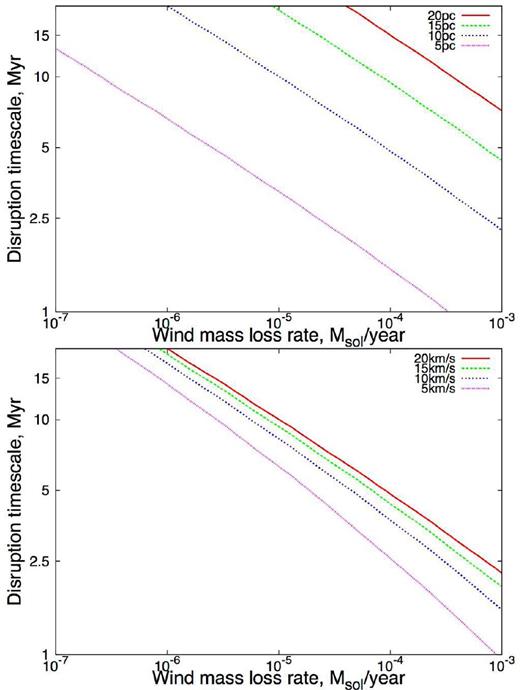
The time-scale for a broad bridge to be disrupted by stellar wind feedback as a function of wind luminosity for different cloud radii (at 20 km s−1 collision, top panel) and collision velocities (for a cloud of 10 pc radius, lower panel). The plots assume that both clouds have a density of 100 mH cm−3.
2.6 The star formation disruption time-scale
2.7 Weaknesses of the analytic arguments
Our arguments made above are purely intended to provide rough lifetime estimates and to build an understanding of how feedback might disrupt the broad bridge feature. They may also assist in a basic interpretation of real observations. However, they have a number of shortcomings.
Simulations by Dale & Bonnell (2011) find that radiative feedback can be ineffective if the H ii region is substantially matter bounded. That is, if photons are able to stream freely from the ionized bubble. This would make radiative feedback much less effective than we predict and so will increase tr.
Regarding both winds and ionizing radiation, we assume that the sources responsible for feedback are colocated. In reality, they will be distributed throughout the colliding layer.
At present there is no consideration of supernovae, which might also be effective at removing broad bridges after about 5 Myr.
We do not account for the effects of turbulence and assume constant deceleration in our collision time-scale estimate.
We assume that the collision is isothermal. In reality, the compressed layer density will likely larger than that given by the isothermal shock condition (equation 10), at least in the absence of turbulence.
3 NUMERICAL COMPARISON
We now study the evolution of the broad bridge feature in two numerical models and compare with our expectations from the analytic expressions. One of the models is without any form of feedback or sink formation, the second includes radiative feedback and sink formation. Neither include feedback from winds.
3.1 Numerical method
3.1.1 Hydrodynamic models
The hydrodynamic models that we post process are simulations of cloud–cloud collisions by Takahira et al. (2014) and Shima et al. (in preparation). These models were both run using the grid-based radiation hydrodynamics code enzo (Bryan et al. 2014). They both consider head-on collisions between two non-identical, turbulent clouds.
The collision with feedback and sink particles is the 20 km s−1 collision model from Shima et al. (in preparation). A summary of the cloud parameters is given in Table 1. Once sink particles form in this simulation, they are assumed to have an ionizing luminosity of 3 × 1046 photons s−1 M|$_{{\odot }}^{-1}$|. In this model, both clouds are travelling in opposite directions at 10 km s−1. We consider snapshots at 0.4, 2, 2.4, 4.4 and 5.4 Myr after the onset of collision. At 2.4 Myr, there is approximately 100 Mȯ in sink particles, implying an ionizing flux of 3 × 1048 photons s−1; this is the value we use in our radiative feedback disruption time-scale estimate.
Summary of the parameters of the feedback model from Shima et al. (in preparation).
| Parameter . | Value . | Description . |
|---|---|---|
| R1 | 14.45 pc | Smaller cloud radius |
| R2 | 27.93 pc | Larger cloud radius |
| ρ1 | 24.4 mH cm−3 | Smaller cloud density |
| ρ2 | 11.79 mH cm−3 | Larger cloud density |
| vc | 20 km s−1 | Collision velocity |
| Δv1 | 1 km s−1 | Smaller cloud turbulent velocity |
| Δv2 | 1.49 km s−1 | Larger cloud turbulent velocity |
| Q | 3 × 1046 s−1 M|$_{{\odot }}^{-1}$| | Ionizing flux per solar mass |
| Qtot | 3 × 1048 s−1 | Total ionizing flux after 2.4 Myr |
| of collision |
| Parameter . | Value . | Description . |
|---|---|---|
| R1 | 14.45 pc | Smaller cloud radius |
| R2 | 27.93 pc | Larger cloud radius |
| ρ1 | 24.4 mH cm−3 | Smaller cloud density |
| ρ2 | 11.79 mH cm−3 | Larger cloud density |
| vc | 20 km s−1 | Collision velocity |
| Δv1 | 1 km s−1 | Smaller cloud turbulent velocity |
| Δv2 | 1.49 km s−1 | Larger cloud turbulent velocity |
| Q | 3 × 1046 s−1 M|$_{{\odot }}^{-1}$| | Ionizing flux per solar mass |
| Qtot | 3 × 1048 s−1 | Total ionizing flux after 2.4 Myr |
| of collision |
Summary of the parameters of the feedback model from Shima et al. (in preparation).
| Parameter . | Value . | Description . |
|---|---|---|
| R1 | 14.45 pc | Smaller cloud radius |
| R2 | 27.93 pc | Larger cloud radius |
| ρ1 | 24.4 mH cm−3 | Smaller cloud density |
| ρ2 | 11.79 mH cm−3 | Larger cloud density |
| vc | 20 km s−1 | Collision velocity |
| Δv1 | 1 km s−1 | Smaller cloud turbulent velocity |
| Δv2 | 1.49 km s−1 | Larger cloud turbulent velocity |
| Q | 3 × 1046 s−1 M|$_{{\odot }}^{-1}$| | Ionizing flux per solar mass |
| Qtot | 3 × 1048 s−1 | Total ionizing flux after 2.4 Myr |
| of collision |
| Parameter . | Value . | Description . |
|---|---|---|
| R1 | 14.45 pc | Smaller cloud radius |
| R2 | 27.93 pc | Larger cloud radius |
| ρ1 | 24.4 mH cm−3 | Smaller cloud density |
| ρ2 | 11.79 mH cm−3 | Larger cloud density |
| vc | 20 km s−1 | Collision velocity |
| Δv1 | 1 km s−1 | Smaller cloud turbulent velocity |
| Δv2 | 1.49 km s−1 | Larger cloud turbulent velocity |
| Q | 3 × 1046 s−1 M|$_{{\odot }}^{-1}$| | Ionizing flux per solar mass |
| Qtot | 3 × 1048 s−1 | Total ionizing flux after 2.4 Myr |
| of collision |
The collision without feedback or sink particles (i.e. without star formation) is the 10 km s−1 collision model from Takahira et al. (2014). A summary of the clouds parameters is given in Table 2. In this model, the collision is in such a frame that the larger cloud is stationary. We consider snapshots at 0.1, 0.2, 1, 1.6, 2.6 and 4.4 Myr after the onset of the collision.
Summary of the parameters of the feedback model from Takahira et al (2014).
| Parameter . | Value . | Description . |
|---|---|---|
| R1 | 3.5 pc | Smaller cloud radius |
| R2 | 7.2 pc | Larger cloud radius |
| ρ1 | 47.4 mH cm−3 | Smaller cloud density |
| ρ2 | 25.3 mH cm−3 | Larger cloud density |
| vc | 10 km s−1 | Collision velocity |
| Δv1 | 1.25 km s−1 | Smaller cloud turbulent velocity |
| Δv2 | 1.71 km s−1 | Larger cloud turbulent velocity |
| Parameter . | Value . | Description . |
|---|---|---|
| R1 | 3.5 pc | Smaller cloud radius |
| R2 | 7.2 pc | Larger cloud radius |
| ρ1 | 47.4 mH cm−3 | Smaller cloud density |
| ρ2 | 25.3 mH cm−3 | Larger cloud density |
| vc | 10 km s−1 | Collision velocity |
| Δv1 | 1.25 km s−1 | Smaller cloud turbulent velocity |
| Δv2 | 1.71 km s−1 | Larger cloud turbulent velocity |
Summary of the parameters of the feedback model from Takahira et al (2014).
| Parameter . | Value . | Description . |
|---|---|---|
| R1 | 3.5 pc | Smaller cloud radius |
| R2 | 7.2 pc | Larger cloud radius |
| ρ1 | 47.4 mH cm−3 | Smaller cloud density |
| ρ2 | 25.3 mH cm−3 | Larger cloud density |
| vc | 10 km s−1 | Collision velocity |
| Δv1 | 1.25 km s−1 | Smaller cloud turbulent velocity |
| Δv2 | 1.71 km s−1 | Larger cloud turbulent velocity |
| Parameter . | Value . | Description . |
|---|---|---|
| R1 | 3.5 pc | Smaller cloud radius |
| R2 | 7.2 pc | Larger cloud radius |
| ρ1 | 47.4 mH cm−3 | Smaller cloud density |
| ρ2 | 25.3 mH cm−3 | Larger cloud density |
| vc | 10 km s−1 | Collision velocity |
| Δv1 | 1.25 km s−1 | Smaller cloud turbulent velocity |
| Δv2 | 1.71 km s−1 | Larger cloud turbulent velocity |
3.1.2 Radiative transfer
As for our original synthetic observations in Haworth et al. (2015), we use the torus radiation transport and hydrodynamics code to post-process simulations in this paper (Harries 2000; Kurosawa et al. 2004; Haworth & Harries 2012). In particular, we use the molecular line transfer algorithm discussed by Rundle et al. (2010) and Haworth et al. (2013). torus is capable of non-local thermodynamic equilibrium (LTE) statistical equilibrium calculations, which were used in Haworth et al. (2015); however, since we are post-processing a relatively large number of snapshots in order to study the time evolution of broad bridges we assume LTE when calculating the molecular level populations in this paper. This does not alter the qualitative p–v diagram (we are only studying the morphological evolution) and substantially reduces our computational expense. With the level populations calculated, a synthetic data cube is generated using ray tracing (Rundle et al. 2010). This data cube is manipulated using the starlink image analysis tool gaia to produce p–v maps. In this paper, we produce synthetic 12CO (J = 1 → 0) data assuming an abundance relative to hydrogen of 8 × 10−5.
3.2 Results of synthetic observations
3.2.1 20 km s−1 collision model from Shima et al. (in preparation)
We first apply our analytic arguments to a 20 km s−1 collision between two large clouds studied by Shima et al. (in preparation). The parameters of this model are given in Table 1. In Fig. 6, we plot the broad bridge disruption time-scales based on the exit time-scale (equation 6), wind/radiative feedback (equations 9 and 14) and star formation rate (equation 17) for this model. We allow the star formation rate and wind mass-loss rate to vary and use the known ionizing flux of stars in the simulation at 2.4 Myr (3 ×1048 photons s−1). From these disruption time-scales, we expect the broad bridge to be first disrupted after about 3.5 Myr because the smaller cloud has exited the larger (see the red small-dotted horizontal line in Fig. 6). High star formation rates or wind mass-loss rates are required to disrupt the broad bridge on a comparable time-scale. We expect that radiative feedback would require about 11 Myr to clear the broad bridge.
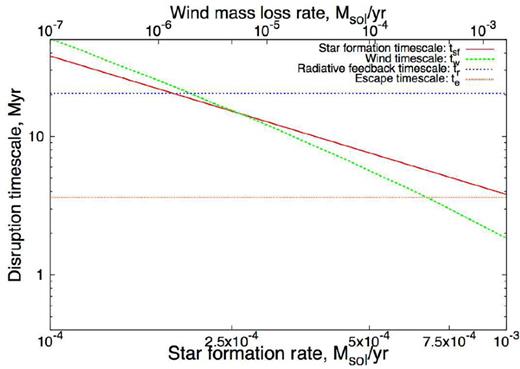
Various time-scales for associated with the broad bridge for the 20 km s−1 collision model from Shima et al. (in preparation). tsf, tr and tw are the time it takes for star formation, radiative feedback and wind feedback to quench the broad bridge. te is the time it takes for the small cloud to punch through the larger cloud.
Fig. 7 shows the p–v diagram for this model at 0.4, 2, 2.4 and 4.4 Myr after the onset of collision. In the upper-left panel, the clouds have only just begun colliding. This snapshot is at a time earlier than the time-scale for crossing the small cloud at the collision velocity. At this stage in the collision, the p–v diagram just looks like clouds coincident along the line of sight (though there is some very weak intermediate-velocity emission). As the collision progresses the broad bridge forms, getting harder to identify as the two intensity peaks approach one another and as the smaller cloud's signature becomes more disordered. By 4.4 Myr (bottom-right panel), the broad bridge is obviously not present, consistent with the result expected from our simple analytic estimates. Although the broad bridge is not observable, there is disordered emission from gas over a 10 km s−1 velocity range at this time. By 4.4 Myr, the larger cloud's feature has also started to be significantly disrupted. The larger feature also appears to decrease in velocity dispersion with time (its thickness along the velocity axis decreases). This is due to dissipation of the turbulence, either by collisions or dilution in the wider interstellar medium.
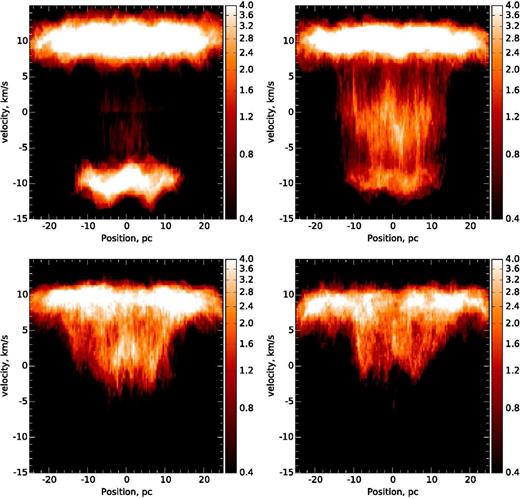
12CO (J = 1 → 0) synthetic p–v diagrams of snapshots from the 20 km s−1 collision model from Shima et al. (in preparation). The panels are for snapshots at 0.4 (top left), 2 (top right), 2.4 (bottom left) and 4.4 Myr (bottom right).
Our analytic arguments give a broad bridge lifetime consistent with the observations to within at least 1 Myr in this case. According to these arguments, the broad bridge lifetime in this scenario is determined by the collision lifetime, rather than feedback. Though it is likely that conversion of gas into stars, feedback and the collision lifetime do all cumulatively contribute, meaning that the collision lifetime estimate is likely an upper limit on the broad bridge lifetime.
3.2.2 10 km s−1 collision model from Takahira et al (2014)
We now apply our analytic arguments to the 10 km s−1 collision model from Takahira et al. (2014), the parameters of which are summarized in Table 2. Unlike in the previous model, this does not include any radiative feedback or star formation. The disruption time-scales for this model are shown in Fig. 8, where we assume an ionizing luminosity an order of magnitude lower than that in the previous model (1047 photons s−1). In this collision between smaller clouds, our analytic arguments predict that star formation as well as radiative and wind feedback will be much more effective at disrupting the broad bridge – to the extent that they can readily dominate over the collision time-scale. Recall that since the radiative disruption time-scale scales as |$R_{\rm s}^{7/4}$| but only |$N_{{\rm ly}}^{-1/4}$|, a reduction of the cloud size by a factor of 10 requires a reduction in the ionizing luminosity by a factor of 107 to maintain the same disruption time-scale. The simulations in Takahira et al. (2014) did not include star formation or feedback. Since the predicted escape time-scale is smaller than the radiative one, we do not expect radiative feedback to be important to the broad bridge lifetime.
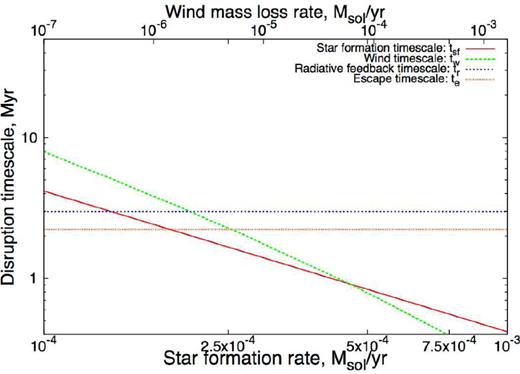
Various time-scales for associated with the broad bridge for the 10 km s−1 collision model from Takahira et al (2014). tsf, tr and tw are the time it takes for star formation, radiative feedback and wind feedback to quench the broad bridge. te is the time it takes for the small cloud to punch through the larger cloud.
p–v diagrams for snapshots of this model at 0.1, 1, 1.6 and 2.6 Myr are shown in Fig. 9. There is similar evolution to the other collisional model, only with less small-scale clumpy structure due to the lack of conversion of gas into stars, as well as a lack of feedback. The bottom-right panel of Fig. 9 is 0.2 Myr after the exit time-scale predicts that the broad bridge should be disrupted. Although some remnant of a secondary intensity peak remains, it has been predominantly disrupted and is no longer so ‘broad’. The actual exit time in the simulation is about 2.8 Myr, compared to our analytic estimate of 2.2 Myr. This difference is consistent with our findings in Section 2.3.1, where the actual collision velocity in the simulations was typically slightly lower than the analytic relations predict. This is due to lack of treatment of processes such as turbulent pressure and gravity.
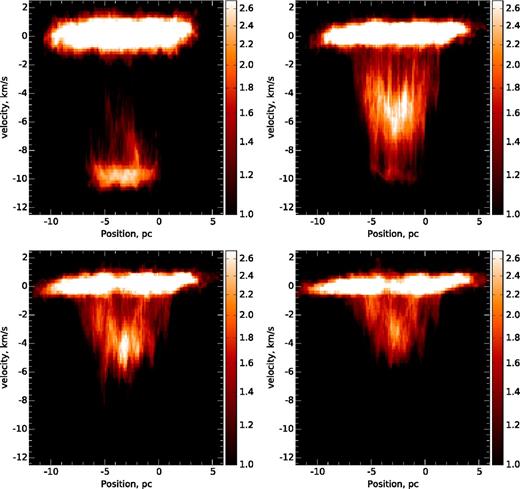
12CO (J = 1 → 0) synthetic p–v diagrams of snapshots from the 10 km s−1 collision model from Takahira et al. (2014). The panels are for snapshots at 0.1 (top left), 1 (top right), 1.6 (bottom left) and 2.6 Myr (bottom right).
4 DISCUSSION
4.1 On the cloud–cloud collision rate
We have developed tools for estimating broad bridge lifetimes which, where testable, seem to be consistent with our numerical models. In general, we expect broad bridge lifetimes of around 1–5 Myr. To date, seven broad bridge features have been identified in the Galaxy. Six of these are strong: M20 (Torii et al. 2011; Haworth et al. 2015), RCW 120 (Torii et al. 2015), NGC 3603 (Fukui et al. 2014), RCW 38 (Fukui et al. 2015), NGC 6334 and NGC 6357. Westerlund 2 also shows a weak broad bridge feature (Furukawa et al. 2009). Dobbs et al. (2015) predict collisions of the order 1 every 10 Myr for clouds of size 10 pc or larger, which would be inconsistent with the amount of broad bridge features currently observed (which are a lower limit, given that more may yet be observed) if our typical broad bridge lifetimes are correct.
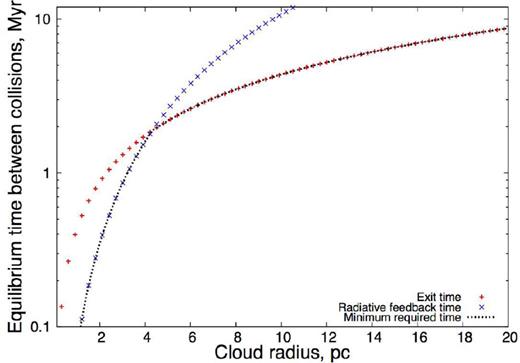
The time between cloud–cloud collisions as a function of cloud radius assuming that an equilibrium number of broad bridge features is maintained. This is for collision parameters discussed in Section 4.1.
For clouds larger than about 5 pc, the exit time-scales require collision rates consistent with those calculated by Dobbs et al. (2015), but for smaller clouds (not identified in the Dobbs et al. 2015, estimates) the collision rates are expected to be much higher (this is required by both the exit and radiative feedback time-scales). Of the systems observed to host broad bridges, NGC 6334 and NGC 6357 are approximately 10 pc in size; however, all others are less than 4 pc. For the example of M20 which is about 2 pc in size, from our equilibrium consideration we expect about four such collisions per Myr. This is in contrast to the Dobbs et al. (2015) general value of about 1 per 10 Myr. It is therefore possible that high cloud–cloud collision rates, leading to massive star formation, are present in the Galaxy that are not contradictory to those rates expected from Dobbs et al. (2015). Higher collision rates for smaller clouds could be tested using new galactic models that are able to identify clouds below 10 pc in size. If higher collision rates for smaller clouds are found, this would call for further detailed simulations of the collisional process. In particular, to understand the link between the properties of the colliding clouds (e.g. radius, density, turbulence, collision velocity) and any subsequent star formation (e.g. star formation efficiency and mass spectrum), which might be compared with observations of candidate collision sites.
5 SUMMARY AND CONCLUSIONS
We study the lifetimes of broad bridge features in p–v diagrams. We do so using a combination of analytic arguments and by post-processing hydrodynamic and radiation hydrodynamic simulations of cloud–cloud collisions. We draw the following main conclusions from this work.
We derived simple analytical tools to estimate broad bridge lifetimes. The lifetime of the broad bridge is constrained by either the collision time-scale, the time-scales for disruption by winds or radiative feedback and the time-scale for the depletion of gas through star formation.
The radiative feedback lifetime tR scales with the ionizing flux as |$t_{\rm R}\propto N_{{\rm ly}}^{-1/4}$| and the smaller cloud radius as |$t_{\rm R}\propto R_{\rm s}^{7/4}$|. This implies that to maintain a given radiative feedback disruption time-scale for smaller clouds, the ionizing flux needs to be more drastically reduced. Due to this effect, although larger clouds have their broad bridge lifetimes determined by the collision time-scale, for smaller clouds feedback can play a dominant role in determining the broad bridge lifetime.
If we assume that there should be some constant number of broad bridges with time, then the disruption time-scales should be roughly equal to the time between collisions at a given cloud size. If this is the case, our disruption time-scales give collision rate estimates. We find that such estimates are readily consistent with the 1 per 10 Myr collision rate estimates by Dobbs et al. (2015) for clouds larger than about 6 pc. However, for smaller clouds (which Dobbs et al. 2015, do not consider) we find much high collision rates, for example 4 per Myr for 2 pc radius clouds.
Given conclusion (3) and the fact that most high-mass star formation sites where broad bridges have been identified are less than 4 pc in size, we suggest that a large number of smaller scale cloud–cloud collisions could be triggering a substantial amount of high-mass star formation.
ACKNOWLEDGMENTS
We thank the referee for their insightful and thorough review, which led to the introduction of some interesting new aspects to the paper. TJH is funded by the STFC consolidated grant ST/K000985/1. EJT is funded by the MEXT grant for the Tenure Track System. Enzo simulations were carried out on the Cray XC30 at the Center for Computational Astrophysics (CfCA) of the National Astronomical Observatory of Japan. This research was supported by the DFG cluster of excellence ‘Origin and Structure of the Universe (JED)’. AH is supported by JSPS KAKENHI Grant Number 15K05014.
REFERENCES
APPENDIX A: THE THICKNESS OF THE DENSE LAYER
Here we discuss the assumption that the slab thickness is less than the Strömgren radius. We begin by noting that this criterion is not essential and that so long as the layer is not much larger than the Strömgren radius (meaning that the H ii region will expand beyond the slab thickness quite quickly) our results are unaffected.
We note that if ram pressure dominates over self-gravity, then the dense layer description of Whitworth et al. (1994) would be more appropriate than the self-gravitating one considered here.




